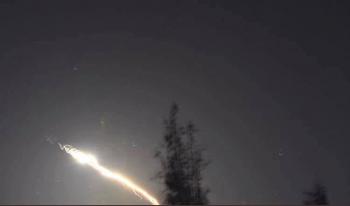Summary
On Aug. 31 at about 10:30 p.m. in Edmonton and area, people may have seen a burst of light flash through the night sky.
Many people saw the fireball, and using data from the University of Alberta’s all sky network camera at Lakeland College, scientists have verified the trajectory of it, along with the potential area where any meteorites associated with the event may have fallen.
The fireball ended 20 km above Camrose, which explains some reports of a sonic boom by residents of the area on that August evening.
In spite of hours of searching in the fall zone, however, just south of Camrose, Alta, no meteorites have been recovered.
“While we haven’t found any meteorites yet, we are confident that they are out there,” explained Chris Herd, professor in the Department of Earth and Atmospheric Sciences and curator of the University of Alberta Meteorite Collection.
“Estimates of the amount of meteorite material that reached the ground is in the range of only about 1 kg, but it might be hiding in farmers’ fields, which we cannot get to yet.”
Crops are late because of the wet summer, so it could be a few weeks before more searching can take place.
But before people set off on a meteorite hunting expedition, there’s a few things you need to know: meteorites belong to the landowner. Any meteorites found on public right of ways —such as along roads—belong to the finder, although researchers at the University of Alberta are keen to study meteorites from this event.
“Every newly fallen meteorite is like a spacecraft bringing a sample back from an asteroid or another planet. It’s a chance to study a nearly pristine sample from space,” said Herd.
If you think you’ve found a meteorite? Visit ualberta.ca/science/meteorites to find out.

